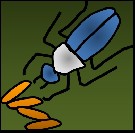Insects in rice cropping
An ecosystem is a natural environment made up by dynamic interactions between biotic and abiotic elements within well-defined boundaries. The biotic elements include plants, insects (pests, natural enemies, decomposers), microbes and other living organisms. The abiotic elements include the weather, relative humidity, wind, sunlight, rain and soil. Each element has its own specific characteristics and plays its own particular role in the system in space and time, influencing the distribution of living organisms. The term ecosystem also includes the flows of nutrients and energy inside the system.
The rice ecosystem is a grouping of biotic and abiotic elements complex enough to provide a measure of stability. However, pesticide use will generally disturb this, balance because both natural enemies and other non-target organisms may be killed by the treatment.
The concepts underlying the integrated management of insect pests and integrated rice management (IRM) are based on the stability of the agro-ecosystem and on economic efficacy. When the stability of the agro-ecosystem is maintained, the populations of insect pests can be kept to levels that are easy to manage. In order to achieve this, the following points must be taken into account:
-
The number, position, role and intensity of all the elements in the ecosystem change, transform or evolve continuously. They build a living system, continually changing, i.e. it is a dynamic ecosystem.
-
In all ecosystems there is a hierarchical structure. For instance, plants produce biomass that feeds herbivores (which include insect pests). These are in turn eaten by carnivores (including their own natural enemies) that are in turn eaten by other carnivores. At the end of the process, all organisms feed the decomposers. If, in an agro-ecological system, there are no natural enemies at all, the insect pests will multiply and destroy the crop. This is why natural enemies living in the fields are an important mechanism of protection—maintaining the balance among all the elements in the ecosystem is essential for its sustainability.
Biodiversity
A healthy ecosystem has a high degree of diversity, in terms of the number of species and the genetic diversity of the individuals within the species. In practice, this means that in such an ecosystem there are several different kinds of plants and animals. Among the useful animals, one may include worms that increase soil fertility and ‘natural enemies’ like spiders, scale insects, frogs and lizards, which help reduce or destroy insect pests. If there are few useful animals in an agro-ecosystem, this may be due a number of problems, e.g.:
-
too much pesticide has been used and these useful animals have been killed.
-
there is not enough food for these natural enemies. In their larval stages, most natural enemies eat other animals (e.g. caterpillars, grasshopper nymphs), whereas adults can live from nectar or pollen from the wild plants in the environment. That is why a large variety of plants is necessary in order to maintain the populations of natural enemies. The more diversified the vegetation of an agro-ecosystem, the more diversified the populations of natural enemies, which means that the chances of naturally destroying the populations of insect pests will be greater.
-
the structure of the soil does not allow worms and insects to grow. Unfavorable conditions for soil inhabitants include soil not containing enough organic matter or fields being flooded too frequently.
Natural enemies
Large animals usually live longer and have fewer offspring, while smaller animals have shorter life cycles and more offspring. Insects have huge numbers of offspring. One pair of stem borers may have 100 offspring that will all become adults. If, in one month, each female produces 100 surviving and productive offspring, the stem-borer population would reach 30 billion within six months. Fortunately, several mortality factors naturally reduce the increase of insect populations. The growth of all living organisms is regulated by unfavorable environmental conditions and by natural enemies.
What is a natural enemy?
A natural enemy is a living organism that kills, harms and causes disease in other living organisms. There are three types of natural enemies:
-
Predators are animals that hunt and kill other animals, e.g. tigers, snakes, spiders or ladybird (ladybug) beetles. The body of a predator is adapted to hunting, killing and eating its prey. In general, predators have strong teeth and mouths, acute vision and strong legs.
-
Parasites also consume other organisms, but they enter (or attach themselves to) the body of their victims and feed on their tissues and fluids, which weakens and even kills them. Parasites thus live at the expense of another organism that is the victim or ‘host’ on which parasites feed.
-
Pathogens are micro-organisms that cause diseases. Like many parasites, they enter the body of their host, in which they live and multiply, weakening and finally killing their host. Bacteria, fungi and viruses are pathogens.













